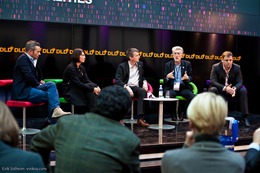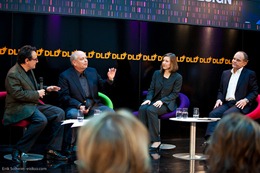Give Up Control, Think Distributed - DLD 2009 Summary
 I was very fortunate to get invited to the 2009 DLD Conference as a participant (Thanks to Yossi Vardi!). This was my first time at DLD and I can definitely say it has been the most amazing conference I have been to so far.
I was very fortunate to get invited to the 2009 DLD Conference as a participant (Thanks to Yossi Vardi!). This was my first time at DLD and I can definitely say it has been the most amazing conference I have been to so far.
As defined by Steffi Czerny “DLD is interdisciplinary, creating interfaces and connecting people from the most different worlds.” the conference’s “New Realities” theme encourages participants to discuss and formulates perspectives on markets following an eventful year, setting the agenda for 2009.
Or as Yossi Vardi defines it:
I told people that of my generation no one will understand instant messaging. And I was told my generation was already dead. But our generation has experiences the new generation does not have: real handshakes and real warmth of the hand. This still has to move into social networks. And this is what we provide here: This old style feeling.
…
We invite you for 4 things:
- to get food for thought
- to make new friends
- to play
- to laugh
Think Distributed
So what is the new reality we’re living in? the repeating theme in most panels I’ve been to was the same:
We’re going through a fundamental change from centralized control (over content, decision making, …) to a distributed structure.
This change becomes very clear when you go over the following panels (and most other panels too):
All these panels talk about a new reality where, in order to survive, you have to give up on centralized control and go distributed.
On the 100 Million Uniques and New Media Models we hear about new distributed media networks that distribute information rather than creating and controlling it. On cloud computing we learn about technologies allowing companies to lose control over infrastructure for increased agility and lower costs, and on On Leadership we have the story of Best Buy that transformed its culture from “communicating at employees” to empowering their employees using social media tools.
Distributed Media
 On New Media Models we’ve heard from Jeff Jarvis who says that the future of media distributed aggregating content from a lot of independent sources rather than controlling the creation of content in-house.
On New Media Models we’ve heard from Jeff Jarvis who says that the future of media distributed aggregating content from a lot of independent sources rather than controlling the creation of content in-house.
On his latest book, “What Would Google Do?” (which I got signed at the event. Thanks Jeff! :)) discusses the importance of building a platform for content, handing over control to users to build and distribute content, making your distributed network larger.
Traditional media companies think centralized. They create and control content and then spend a fortune on advertising in order to try and attract us, the consumers, to their content. This worked pretty well for big online media companies, like Yahoo for example, so far.
However, consumer today are relying more and more on social, self organization tools, to collect, sort, filter and rate content. Tools like Digg, Twitter, delicious and Facebook replace the functions that content portals used to provide.
In this new reality media companies need to stop thinking of themselves as an end a closed content site (or portal) users come to in order to find content and start distributing themselves.
Google distributes itself. It has its widgets, ads, maps and videos embedded in millions of web pages that it doesn’t own and it is making its profit of this vast distribution network.
Another example for distributed content is Glam. On 100 Million Uniques, Samir Arora, CEO of Glam described his company the following way:
“Glam is a distributed network that recognizes the fact that people go to many sites as opposed to a few, and that is the fundamental change that is happening today. So instead of bringing people to one place, we find out where people go and are there.”
“with every day that was passing, fueled by Google, its easier to find more sites, as opposed to one portal.
Instead of producing women targeted content and competing with all the other women content producers out there, Glam finds the best women content producers out there (some are lone bloggers and other can be bigger media companies) and invites them to join its network. It then sells ads on those sites and shares it revenue with them. It also aggregates the best content of its network to Glam.com, where it sells ads at a higher rate and shares its revenues too.
Glam helps sites on its network by sharing technology and content, and delivering traffic (and advertisers) to its member sites.
Distributed Leadership
 Changing from centralized control to a distributed structure is not limited to the media and advertising world.
Changing from centralized control to a distributed structure is not limited to the media and advertising world.
On the On Leadership panel we see how Best Buy made a strategic decision to distributing control to its employees allowing them to self organize and interact using social Web 2.0 tools.
By changing the company culture “Less control from the top, more taking responsibility” the role of the CEO changes from to defining a common goal, not way to get there, and relying the companies human capital to do what it takes to get there.
So some control over what’s going on is lost, but according to Best Buy CEO Brad Anderson, “this stuff builds energy. if people have self accountability and can do something that they helped created and love they got more energy. what a customer would get when he gets into that store is that he could tell whether that store has got energy and engaged employees serving him or not”.
So if there’s one thing I have to take from my time at DLD 2009 its this: give up control, think distributed.
More on DLD:
- No Hope for Traditional Media Companies?
- Creating an Attractive Internet Company – It’s All About Emotions
Recommended session videos:

